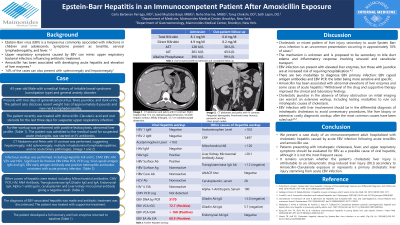Sunday Poster Session
Category: Liver
P1112 - Epstein-Barr Hepatitis in an Immunocompetent Patient After Amoxicillin Exposure
Sunday, October 22, 2023
3:30 PM - 7:00 PM PT
Location: Exhibit Hall

Has Audio

Carla Barberan Parraga, MD
Maimonides Medical Center
Brooklyn, NY
Presenting Author(s)
Carla Barberan Parraga, MD1, Syed Mujtaba Baqir, MBBS1, Neha Sharma, MD2, Tanuj Chokshi, DO3, Seth Lapin, DO1
1Maimonides Medical Center, Brooklyn, NY; 2Maimonides Health, Brooklyn, NY; 3Maimonides Medical Center, Clifton, NJ
Introduction: Epstein-Barr virus (EBV), a herpesvirus, is commonly seen in infections in young children and adolescents. Typical symptoms of EBV infection include tonsillitis, cervical lymphadenopathy, and fever predominant in infectious mononucleosis. 14% of the cases can also present with splenomegaly and hepatomegaly. Some cases can present with jaundice as the initial sign of liver involvement associated with abdominal pain and fever, which can be mistaken for biliary obstruction. Upper respiratory symptoms caused by EBV infection can mimic upper respiratory bacterial infections, influencing antibiotic treatment. Amoxicillin has been associated with the development of acute hepatitis or the elevation of liver enzymes. We describe the case of an immunocompetent adult diagnosed with acute EBV hepatitis following acute tonsilitis and amoxicillin use, with fever, jaundice, pruritis, and marked liver enzyme elevation with a cholestatic pattern requiring hospitalization and treated initially as cholangitis.
Case Description/Methods: We report a case of a 43-year-old immunocompetent male who presents with symptoms of pruritus, fever, jaundice, and dark urine following a recent episode of acute tonsilitis treated with amoxicillin-clavulanic and oral steroids. Physical examination revealed jaundice and cervical lymphadenopathy. Laboratory tests indicated a cholestatic pattern of liver enzyme elevation. The patient was started on intravenous (IV) antibiotics. Imagining, including CT abdomen and pelvis with IV contrast, was significant for splenomegaly, hepatomegaly, and abdominal lymphadenopathy. Further tests, including serology, confirmed EBV hepatitis and ruled out other causes of acute hepatitis. Antibiotic treatment was discontinued, and supportive treatment started. The patient developed a full recovery, and liver enzymes returned to baseline. During the outpatient follow-up visit, the only complaint was residual fatigue.
Discussion: It is unknown whether the Amoxicillin exposure associated with the EBV infection might have precipitated this cholestatic episode in our patient. It is important to consider viral illnesses like EBV, where starting antibiotics can be more detrimental. EBV infection with liver involvement should be in the differential diagnosis of intrahepatic cholestasis to avoid unnecessary procedures, like liver biopsy or extensive, costly diagnostic workup after the most common causes have been ruled out.
Disclosures:
Carla Barberan Parraga, MD1, Syed Mujtaba Baqir, MBBS1, Neha Sharma, MD2, Tanuj Chokshi, DO3, Seth Lapin, DO1. P1112 - Epstein-Barr Hepatitis in an Immunocompetent Patient After Amoxicillin Exposure, ACG 2023 Annual Scientific Meeting Abstracts. Vancouver, BC, Canada: American College of Gastroenterology.
1Maimonides Medical Center, Brooklyn, NY; 2Maimonides Health, Brooklyn, NY; 3Maimonides Medical Center, Clifton, NJ
Introduction: Epstein-Barr virus (EBV), a herpesvirus, is commonly seen in infections in young children and adolescents. Typical symptoms of EBV infection include tonsillitis, cervical lymphadenopathy, and fever predominant in infectious mononucleosis. 14% of the cases can also present with splenomegaly and hepatomegaly. Some cases can present with jaundice as the initial sign of liver involvement associated with abdominal pain and fever, which can be mistaken for biliary obstruction. Upper respiratory symptoms caused by EBV infection can mimic upper respiratory bacterial infections, influencing antibiotic treatment. Amoxicillin has been associated with the development of acute hepatitis or the elevation of liver enzymes. We describe the case of an immunocompetent adult diagnosed with acute EBV hepatitis following acute tonsilitis and amoxicillin use, with fever, jaundice, pruritis, and marked liver enzyme elevation with a cholestatic pattern requiring hospitalization and treated initially as cholangitis.
Case Description/Methods: We report a case of a 43-year-old immunocompetent male who presents with symptoms of pruritus, fever, jaundice, and dark urine following a recent episode of acute tonsilitis treated with amoxicillin-clavulanic and oral steroids. Physical examination revealed jaundice and cervical lymphadenopathy. Laboratory tests indicated a cholestatic pattern of liver enzyme elevation. The patient was started on intravenous (IV) antibiotics. Imagining, including CT abdomen and pelvis with IV contrast, was significant for splenomegaly, hepatomegaly, and abdominal lymphadenopathy. Further tests, including serology, confirmed EBV hepatitis and ruled out other causes of acute hepatitis. Antibiotic treatment was discontinued, and supportive treatment started. The patient developed a full recovery, and liver enzymes returned to baseline. During the outpatient follow-up visit, the only complaint was residual fatigue.
Discussion: It is unknown whether the Amoxicillin exposure associated with the EBV infection might have precipitated this cholestatic episode in our patient. It is important to consider viral illnesses like EBV, where starting antibiotics can be more detrimental. EBV infection with liver involvement should be in the differential diagnosis of intrahepatic cholestasis to avoid unnecessary procedures, like liver biopsy or extensive, costly diagnostic workup after the most common causes have been ruled out.
Disclosures:
Carla Barberan Parraga indicated no relevant financial relationships.
Syed Mujtaba Baqir indicated no relevant financial relationships.
Neha Sharma indicated no relevant financial relationships.
Tanuj Chokshi indicated no relevant financial relationships.
Seth Lapin indicated no relevant financial relationships.
Carla Barberan Parraga, MD1, Syed Mujtaba Baqir, MBBS1, Neha Sharma, MD2, Tanuj Chokshi, DO3, Seth Lapin, DO1. P1112 - Epstein-Barr Hepatitis in an Immunocompetent Patient After Amoxicillin Exposure, ACG 2023 Annual Scientific Meeting Abstracts. Vancouver, BC, Canada: American College of Gastroenterology.
